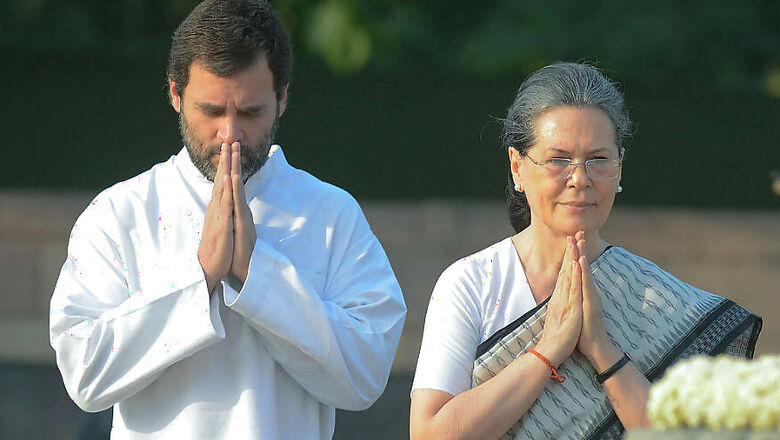
views
Last week a story broke on CNN-News18 that Rahul Gandhi had decided to take a backseat in the impending organisational polls and it would be mother Sonia Gandhi who would continue to lead the Indian National Congress till the 2019 polls.
Whether this is a decision that has already been taken by the party leadership or it is a thought process underway in the Congress, yet to fructify into a concrete decision, will become clear before long. For, otherwise, Rahul Gandhi was all set to take over from his mother as Congress President in October when the election process in the party is completed.
Interestingly, the story is neither being denied nor confirmed. Senior party leaders say Rahul Gandhi would be willing enough to have his mother continue in the lead role, but it is Sonia Gandhi who had to be persuaded to lead from the front once again, but that she might agree if there was pressure from within the party, particularly from the senior leaders.
In recent months, Sonia Gandhi who had virtually abdicated in favour of Rahul Gandhi — with her public appearances becoming few and far between — has come upfront again.
When Nitish Kumar called on her in April this year to urge her to take the initiative to field joint opposition candidate for President, she immediately called 18 parties to her residence. It is another matter that the Congress leadership dithered on announcing Gopal Gandhi’s name for President, as sought by regional parties and the initiative was wrested by the BJP which announced Ram Nath Kovind as its nominee.
She reseized the initiative by announcing Gopal Gandhi as the Opposition’s choice for Vice President, bringing Nitish Kumar back into the opposition fold.
She has also tried to play a behind the scenes role in trying to find a way out of the impasse in Bihar between Nitish Kumar and Lalu Yadav, and Sharad Yadav called on her to get her to use her good offices between the two Bihar leaders, to save a teetering Mahagathbandhan.
Clearly, Sonia Gandhi’s leadership is acceptable to the regional satraps, which is not the case with Rahul Gandhi. Sonia could still act as the “sutradhar” of opposition unity.
Again, this is a role more difficult for Rahul to play. Regional chieftains would hear and heed her in the role of a troubleshooter, ironing out the differences and angularities that are bound to crop up. Regional party leaders do not have the confidence that Rahul will be able to do that.
More importantly, Rahul is not seen at the popular level as someone who can take on Narendra Modi. This may change at a future date, if anger against the Modi dispensation builds up.
But, for the moment, Modi not only retains his popularity but the UP results showed that he has consolidated his grip. He has turned the traditional vote base of the BJP on its head, and gone on to win the poorer sections — Dalits, OBCs, MBCs, tribals — apart from the middle class and upper castes that had looked at the party with favour over the years.
That there has been a campaign to rubbish — and do down — Rahul Gandhi by those in the opposition and also by some inside the Congress could have an element of truth in it. But it is also a fact that neither Rahul nor his team have been able to get on top of the situation. The upshot: Rahul does not generate public confidence today about his ability to lead and take on Narendra Modi.
Where does this leave the Congress? And indeed the entire Opposition? For, if there is something that successive elections have made clear, it is that the opposition parties have to join hands to have any chance of reining in the BJP.
This will entail the creation of not just an overarching unity but also a nuts and bolts crafting of one-on-one fights at the constituency-level between the NDA and one or another opposition parties, to prevent a split in the opposition votes.
The Congress’ dilemma is well-known and has centred around the conundrum that it cannot do without a Nehru-Gandhi to lead it, but with Rahul, there is little chance of victory against Modi.
Of late, there is a view gaining ground in the party that Sonia Gandhi should continue to lead till 2019. This will also facilitate opposition consolidation, as important as the need for clarity on the leadership question inside the Congress.
The only catch is that while Sonia Gandhi cannot be the prime ministerial candidate, either of the Congress or of the entire opposition, having renounced the top job in 2004, the absence of a convincing chehra on the opposition side to take on Modi is the biggest minus point for the opposition.
Of course, the Congress could try and package BRAND CONGRESS as its Unique Selling Point, but it would have limited value in this day and age of presidential campaigns and more so when the party has to contend with someone like a Modi on the other side.
The Congress need not split, as feared, if there is a non-Nehru Gandhi heading the party or a non-Congress leader leading the entire phalanx of opposition parties opposed to the NDA — provided the Gandhi family decides to back that person. A Nitish Kumar? A Meira Kumar? A Gopal Gandhi? A dark horse?
At the end of the day, Congress revival and opposition prospects depend on the mistakes Narendra Modi makes in the coming months and whether or not he starts to lose ground.
(Neerja Chowdhury is a political commentator. Views are personal)




















Comments
0 comment